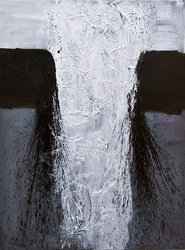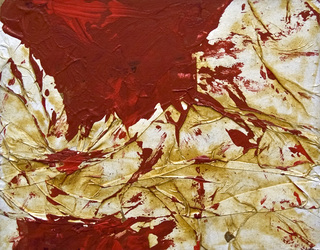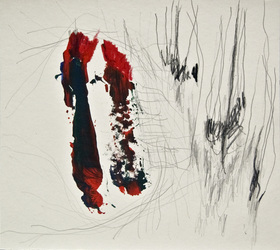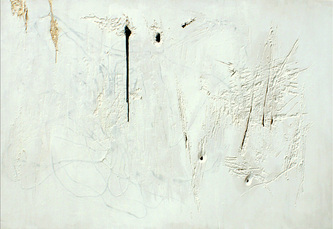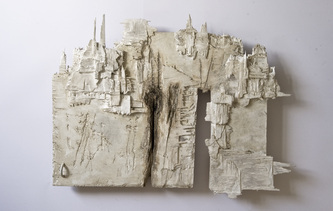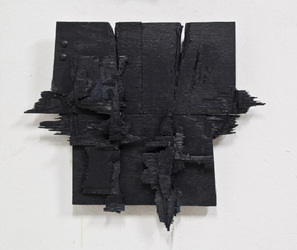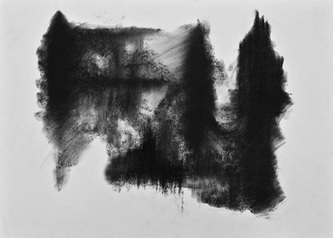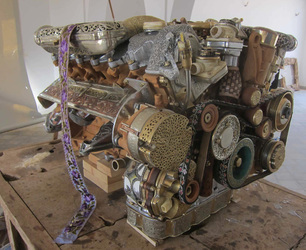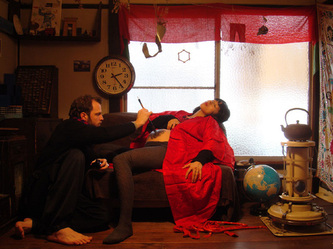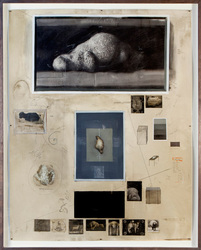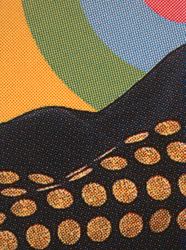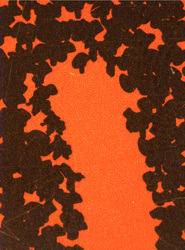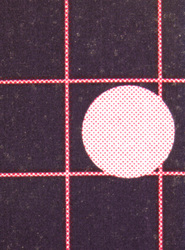EXHIBITION ARCHIVE
2013
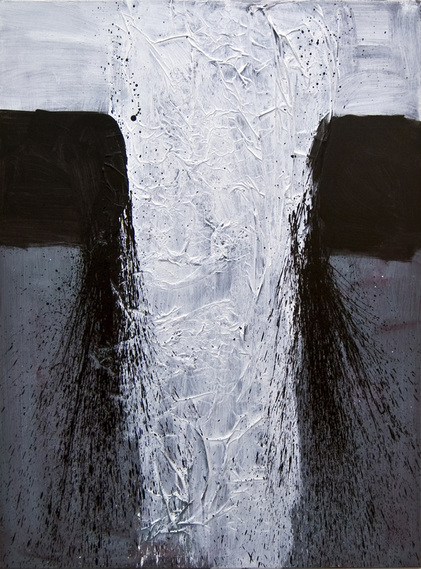 Mother Milk , 2013, 120x90cm, Oil and Paper on Canvas, Mixed media
Mother Milk , 2013, 120x90cm, Oil and Paper on Canvas, Mixed media
KONSTANTINO DREGOS
"CHRONAXIA"
November 12 - December 7, 2013
Opening Tuesday November 12th, 2013
6pm - 9pm
Strict RSVP on door
Please RSVP to [email protected]
With his works, the Berlin based artist Konstantino Dregos (Athens, 1977) directs to the viewer duties such as approaching, perceiving and understanding. His pieces are urging us to remain attentive and discover the contained intensity that lies in each of them. In 2008, when he moved to Berlin, and taking as a frame of reference Barnett Newman, Ellsworth Kelly or Giorgio Morandi among others, he leaves aside figurative painting in order to enter the world of object-hood. This process of „ruinvention“ was reflected in his series Chamber Plates of monochrome sculptures on plywood.
Dregos draws a thin line between the ideas of destruction and unity through a variety of artistic strategies. The dynamism, strength and action of destruction are transmuted into cuts, dismemberments or perforations in his sculptures on plywood or on industrial materials such as rubber.
He juxtaposes this destructive sense to the constructive character by means of wood applications, modelling of materials such as a moving blanket and the exercise of intense brushstrokes on the canvas. As destruction is linked to creation, the same strength, action and determination can be observed in the reconstructive procedure, both in painting and sculpture. This all hints the reflective process that the artist undergoes and which results in an analytical product.
By overlapping form and surface and far from intending a narration, his painting brings us to the idea of unit, of the infinity suggested by the philosopher Anaximander. That universal substance, eternal, infi- nite and indeterminate, constantly and eternally moving activity, that „something“ unifies everything.
In the atelier, where diverse music such as Nick Cave or Black Metal sounds in the background, Dregos faces a new work and its materials in a very active, serious and concentrated way. This is where the subject and object cannot be distinguished nor separated, but both conform an unit again.
His works, which involve the dichotomy of the discursive process and the bodily strength, refer to the phenomenology of Merleau-Ponty‘s perception: “Being an experience is to communicate internally with the world (...) and the other, to be like them, instead of beside them.” (Merleau-Ponty)
Dregos‘ perception has an active dimension, insofar it represents a major opening to the world of life. The perceptual experience regards an opening and encounter between the intention of this embodied consciousness and a world that presents to us open and unfinished.
The concern, the rawness and the mystery of his works are based on a subtle harmony. This attraction captures one‘s attention, and keeps us in a state of search and detection. Konstantino Dregos examines the concept of beauty by the notions of body, perception and unit and therefore the beauty of his works lays not on the surface, but rather in the depth of his artistic methodology.
Text courtesy Anna Sanchez de Vivar
2013

Hugo Wilson, detail, sculpture, 2013
“NEAR NARRATIVES”
HUGO WILSON
ERIC VAN HOVE
CURATED BY JEAN-PHILIPPE VERNES
OCTOBER 8 - NOVEMBER 2, 2013
OPENING RECEPTION
OCTOBER 8, 6-9 PM
R.S.V.P. to [email protected]
The works by Hugo Wilson and Eric Van Hove are both asking if “Post Modern Art “ can still tell great stories?
The fundamental condition of storytelling throughout the ages is that which has been lived through and that which has been experienced. First hand accounts turn into second hand rumors, which through the passing of time, either enter the realm of myth or simply whither away.
Hugo Wilson’s work starts from the examination of what it is to manifest faith in an object or image. He is primarily interested in how and why groups of people choose to do this and he is interested in distilling the essence of these objects, removing their exact secular symbolism and creating a new narrative from the result, one of uncertainty and of reaching out through the history of image making.
Hugo Wilson brings his highly developed skills of traditional Old master iconography both in sculpture, painting and etching, to suggest that we have subconsciously seen his scenes and tableaux in the past, but actually, we have not. The artist’s ability to blend our vague communal memories and direct these souvenirs of art history into his work ultimately leads us, the viewer to reflect on what art actually is and what it is that may remain in the eye of the beholder.
Eric Van Hove examines similar ideas but broadcasts on a different frequency. His work of a deconstructed Mercedes Benz V12 engine, painfully reconstructed in minute detail by the best Moroccan craftsmen and artisans, shows that 21st century European technology can be replicated with the ancestral know how of hands and not a computer. Van Hove asks the question of both the transfer of knowledge and the creation of a body of sculpture that we may recognize at first for it’s literal content, but which ultimately blurs the lines and introduces suspension of disbelief.
Eric van Hove’s examination of text, through his skills as a traditionally trained calligrapher in his Metagram series, offers us a similar journey through playful intertextuality and uncertainty, yet with a completely different visual result - one that is immediate and visceral but also one that pays homage to the many layers of history that these images refer to.
For more information and for a list of works, please contact Jean-Philippe Vernes on [email protected] or call the gallery on +44-207-4931488
The gallery is open by appointment.
HUGO WILSON
ERIC VAN HOVE
CURATED BY JEAN-PHILIPPE VERNES
OCTOBER 8 - NOVEMBER 2, 2013
OPENING RECEPTION
OCTOBER 8, 6-9 PM
R.S.V.P. to [email protected]
The works by Hugo Wilson and Eric Van Hove are both asking if “Post Modern Art “ can still tell great stories?
The fundamental condition of storytelling throughout the ages is that which has been lived through and that which has been experienced. First hand accounts turn into second hand rumors, which through the passing of time, either enter the realm of myth or simply whither away.
Hugo Wilson’s work starts from the examination of what it is to manifest faith in an object or image. He is primarily interested in how and why groups of people choose to do this and he is interested in distilling the essence of these objects, removing their exact secular symbolism and creating a new narrative from the result, one of uncertainty and of reaching out through the history of image making.
Hugo Wilson brings his highly developed skills of traditional Old master iconography both in sculpture, painting and etching, to suggest that we have subconsciously seen his scenes and tableaux in the past, but actually, we have not. The artist’s ability to blend our vague communal memories and direct these souvenirs of art history into his work ultimately leads us, the viewer to reflect on what art actually is and what it is that may remain in the eye of the beholder.
Eric Van Hove examines similar ideas but broadcasts on a different frequency. His work of a deconstructed Mercedes Benz V12 engine, painfully reconstructed in minute detail by the best Moroccan craftsmen and artisans, shows that 21st century European technology can be replicated with the ancestral know how of hands and not a computer. Van Hove asks the question of both the transfer of knowledge and the creation of a body of sculpture that we may recognize at first for it’s literal content, but which ultimately blurs the lines and introduces suspension of disbelief.
Eric van Hove’s examination of text, through his skills as a traditionally trained calligrapher in his Metagram series, offers us a similar journey through playful intertextuality and uncertainty, yet with a completely different visual result - one that is immediate and visceral but also one that pays homage to the many layers of history that these images refer to.
For more information and for a list of works, please contact Jean-Philippe Vernes on [email protected] or call the gallery on +44-207-4931488
The gallery is open by appointment.
2013

Gesine Thomson
'Private Topographies'
September 10, 2013
6-9PM
Thereafter by appointment
Gesine Thomson is an internationally recognized architect, visionary and speaker specializing in large scale community planning and sustainable commercial growth. Her architecture takes her worldwide, and she is currently the chief architect working on a sustainable community development the size of Manhattan. She places great importance of encompassing various art forms, philosophies and future technologies, all whilst keeping the community intact and encouraging sustainable commercial growth, which empowers its residents.
SternArts Ltd. is pleased to present a rare insight into the processes that drive Gesine Thomson’s creative forces. We present a selection of ethereal drawings that, whilst also perfectly broadcasting in their own right, are also tools, which act as springboards that lead Gesine Thomson on to her larger projects.
Some of these drawings, created as landscapes, display eroticism and some are constructed according to the Rorschach principle, which add an interesting layer of dual reading. The Rorschach technique, normally created by opposing inkblots on paper, has been employed to detect underlying thought processes, especially in the formative years of psychoanalysis. Using interpretation of "ambiguous designs" to assess an individual's personality is an idea that goes back to Leonardo da Vinci and Botticelli. In Gesine Thomson’s treatment of the Rorschach subject, the pictures behave more consciously and one can appreciate the architectural construction of the second half of the picture that make up the mirror image, in a meticulous repeat, as supposed to the accidental inkblot.
Other subjects in Gesine Thomson’s works can be considered topographies of the narrative. She was, for instance, invited to stay in the house of the late Michael Jackson recently in order to simply “react” to, both its imposed narrative, and its apparent mythology. Gesine says: “..I was invited to stay there and to perhaps "reset" the myths and its energies, which the former owner had left behind..” The resulting drawings from this remarkable stay are also included in the show.
Gesine Thomson will be one of the speakers at the TED conference in late September and she will give a talk at The Arts Club on November 18th, 2013.
'Private Topographies'
September 10, 2013
6-9PM
Thereafter by appointment
Gesine Thomson is an internationally recognized architect, visionary and speaker specializing in large scale community planning and sustainable commercial growth. Her architecture takes her worldwide, and she is currently the chief architect working on a sustainable community development the size of Manhattan. She places great importance of encompassing various art forms, philosophies and future technologies, all whilst keeping the community intact and encouraging sustainable commercial growth, which empowers its residents.
SternArts Ltd. is pleased to present a rare insight into the processes that drive Gesine Thomson’s creative forces. We present a selection of ethereal drawings that, whilst also perfectly broadcasting in their own right, are also tools, which act as springboards that lead Gesine Thomson on to her larger projects.
Some of these drawings, created as landscapes, display eroticism and some are constructed according to the Rorschach principle, which add an interesting layer of dual reading. The Rorschach technique, normally created by opposing inkblots on paper, has been employed to detect underlying thought processes, especially in the formative years of psychoanalysis. Using interpretation of "ambiguous designs" to assess an individual's personality is an idea that goes back to Leonardo da Vinci and Botticelli. In Gesine Thomson’s treatment of the Rorschach subject, the pictures behave more consciously and one can appreciate the architectural construction of the second half of the picture that make up the mirror image, in a meticulous repeat, as supposed to the accidental inkblot.
Other subjects in Gesine Thomson’s works can be considered topographies of the narrative. She was, for instance, invited to stay in the house of the late Michael Jackson recently in order to simply “react” to, both its imposed narrative, and its apparent mythology. Gesine says: “..I was invited to stay there and to perhaps "reset" the myths and its energies, which the former owner had left behind..” The resulting drawings from this remarkable stay are also included in the show.
Gesine Thomson will be one of the speakers at the TED conference in late September and she will give a talk at The Arts Club on November 18th, 2013.
2013
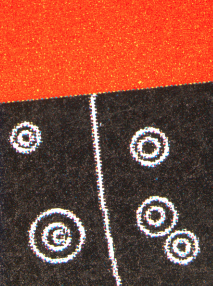
The work of Dmitry Sokolenko is based on the principle of topology and fractality. He uses historical photographic processes to investigate abstract art and its underlying semantic structures. Sokolenko wants to take abstract art to another level, one, which is not imbued with the classic subscriptions to modern art parlance. Rather, he sees a different possibility for visual language, which brings into account the semantic field of shared knowledge between creator and spectator. The aim for Sokolenko is to re-introduce imagery as a readable language.
The viewer is introduced to Dmitry Sokolenko’s work through a set of abstract visual signs. Not created from an artist’s emotive approach, but rather a scientific one. He has a long-standing fascination with the works of Vladimir Nabokov and his studies into entomology and especially the study of butterfly wings. Sokolenko’s reading and interpretation of visual signage is pragmatic, investigative and inquisitive. Nabokov’s research, among others, have left him with a wealth of opportunity to converse through the language of visual semantics. The results are startling tropes and images from the ‘real’, excavated from the post mortem of mechanical reproduction, but which to some may broadcast as specters of the imagined.
Dmitry Sokolenko does not subscribe to the artistic autonomy that most practitioners refer to. Instead he takes a contrarian approach to artistic license, if not an absurdist one. He underscores his disassociation with being called an artist all together.
This brings his works closer to that of the early Soviet revolutionary avant-garde and one can find close relationships between Sokolenko’s practise and that of absurdist poetry, say, from writers such as Alexander Vvedensky, who challenged the very fabric of language and it’s limitations in service of production. Sokolenko’s works offer a re-boot in the thought process that everything that makes up the human experience are reduced to a set of signs and impulses from the real. That there is a commonly shared ground, which offers its visual signs as pure experience.
Dmitry Sokolenko was born in 197X.
He obtained a diploma in Microbiology, specialising as a bio-technical engineer in 1999.
2012 will mark the end of his attempts to plant a tree on the White House lawn.
He will die in 2014 in the USA, during the Winter Olympics.
For more information about Dmitry Sokolenko and to obtain a full list of works, please contact the gallery.
The viewer is introduced to Dmitry Sokolenko’s work through a set of abstract visual signs. Not created from an artist’s emotive approach, but rather a scientific one. He has a long-standing fascination with the works of Vladimir Nabokov and his studies into entomology and especially the study of butterfly wings. Sokolenko’s reading and interpretation of visual signage is pragmatic, investigative and inquisitive. Nabokov’s research, among others, have left him with a wealth of opportunity to converse through the language of visual semantics. The results are startling tropes and images from the ‘real’, excavated from the post mortem of mechanical reproduction, but which to some may broadcast as specters of the imagined.
Dmitry Sokolenko does not subscribe to the artistic autonomy that most practitioners refer to. Instead he takes a contrarian approach to artistic license, if not an absurdist one. He underscores his disassociation with being called an artist all together.
This brings his works closer to that of the early Soviet revolutionary avant-garde and one can find close relationships between Sokolenko’s practise and that of absurdist poetry, say, from writers such as Alexander Vvedensky, who challenged the very fabric of language and it’s limitations in service of production. Sokolenko’s works offer a re-boot in the thought process that everything that makes up the human experience are reduced to a set of signs and impulses from the real. That there is a commonly shared ground, which offers its visual signs as pure experience.
Dmitry Sokolenko was born in 197X.
He obtained a diploma in Microbiology, specialising as a bio-technical engineer in 1999.
2012 will mark the end of his attempts to plant a tree on the White House lawn.
He will die in 2014 in the USA, during the Winter Olympics.
For more information about Dmitry Sokolenko and to obtain a full list of works, please contact the gallery.
2012

‘LOVE’
14.02.12 – 10.03.12
Opening reception
Tuesday February 14, 2-6pm
Opening hours, Tue-Fri 12-6
or by appointment
Frank Auerbach, Louise Bourgeois, Mat Collishaw, Martin Creed, E V Day, Tracey Emin, Angus Fairhurst, Lucian Freud, Alberto Giacometti, heimatlosevolkskunst a.k.a. Kenno Apatrida, Damien Hirst, David Hockney, Robert Indiana, Rachel Kneebone, Yayoi Kusama, Vik Muniz, Eduardo Paolozzi, Paula Rego, Kiki Smith, Miroslav Tichy, Andy Warhol, Tom Wesselmann and others..
Love is a smoke made with the fumes of sighs; Being purged, a fire sparkling in lovers' eyes;
Being vexed, a sea nourished with lovers' tears; What is it else? A madness most discreet,
A choking gall, and a preserving sweet.
(William Shakespeare, Romeo and Juliet, 1.1.191-5)
Mainstay of music, poetry and literature from classical times to the present day, artists have consistently wrestled with descriptions of what ‘Love’ is, how it affects us and what we can do to handle it. One immediately thinks of Catullus, Ovid, Shakespeare and Keats as writers who devoted almost their entire careers to unraveling the extraordinary feelings, passions and desires inherent in what we loosely describe as ‘Love’. Moving forward to the present day, no successful pop song of the last 50 years is complete without expressions of teenage angst over matters of the heart; think ‘She Loves You’ or ‘What is Love? Baby, don’t hurt me!’
Within the corpus of International Modern and Contemporary Art, however, images of ‘Love’ can be hard to come by. Perhaps the ennui of Post-Modernism snuffed out any chance artists may have had to be candid with their feelings on canvas or paper, except perhaps for a handful of iconic images that we now know so well. But, even here, artists seem only happy to incorporate images of ‘Love’ by distancing themselves from the final product, creating an icon that is somewhat divorced from their private feelings, wryly standing back from the action in a Post-Modernist knowingness.
SternArts Ltd. is pleased to present a group exhibition of international artists whose work goes in some way to deal with both personal and public assumptions on the nature and meaning of ‘Love’. The exhibition further incorporates symbols or icons of ‘Love’ behind which the artist is allowed to hide his or her own private feelings. Robert Indiana’s omnipresent ‘Love’ sculpture or Damien Hirst’s and Andy Warhol’s prints of love hearts are two well-known cases in point which allow the artist to present an image that we know to be about ‘Love’ but which fails to present any illustration of it all the same. Tracey Emin and Kiki Smith offer up their hearts for public examination and certainly we can ‘feel’ with them as we can the mad posturing of Yayoi Kusama; but, through all of this, it is painfully apparent that Contemporary Art is not at ease with wearing its heart on its sleeve.
14.02.12 – 10.03.12
Opening reception
Tuesday February 14, 2-6pm
Opening hours, Tue-Fri 12-6
or by appointment
Frank Auerbach, Louise Bourgeois, Mat Collishaw, Martin Creed, E V Day, Tracey Emin, Angus Fairhurst, Lucian Freud, Alberto Giacometti, heimatlosevolkskunst a.k.a. Kenno Apatrida, Damien Hirst, David Hockney, Robert Indiana, Rachel Kneebone, Yayoi Kusama, Vik Muniz, Eduardo Paolozzi, Paula Rego, Kiki Smith, Miroslav Tichy, Andy Warhol, Tom Wesselmann and others..
Love is a smoke made with the fumes of sighs; Being purged, a fire sparkling in lovers' eyes;
Being vexed, a sea nourished with lovers' tears; What is it else? A madness most discreet,
A choking gall, and a preserving sweet.
(William Shakespeare, Romeo and Juliet, 1.1.191-5)
Mainstay of music, poetry and literature from classical times to the present day, artists have consistently wrestled with descriptions of what ‘Love’ is, how it affects us and what we can do to handle it. One immediately thinks of Catullus, Ovid, Shakespeare and Keats as writers who devoted almost their entire careers to unraveling the extraordinary feelings, passions and desires inherent in what we loosely describe as ‘Love’. Moving forward to the present day, no successful pop song of the last 50 years is complete without expressions of teenage angst over matters of the heart; think ‘She Loves You’ or ‘What is Love? Baby, don’t hurt me!’
Within the corpus of International Modern and Contemporary Art, however, images of ‘Love’ can be hard to come by. Perhaps the ennui of Post-Modernism snuffed out any chance artists may have had to be candid with their feelings on canvas or paper, except perhaps for a handful of iconic images that we now know so well. But, even here, artists seem only happy to incorporate images of ‘Love’ by distancing themselves from the final product, creating an icon that is somewhat divorced from their private feelings, wryly standing back from the action in a Post-Modernist knowingness.
SternArts Ltd. is pleased to present a group exhibition of international artists whose work goes in some way to deal with both personal and public assumptions on the nature and meaning of ‘Love’. The exhibition further incorporates symbols or icons of ‘Love’ behind which the artist is allowed to hide his or her own private feelings. Robert Indiana’s omnipresent ‘Love’ sculpture or Damien Hirst’s and Andy Warhol’s prints of love hearts are two well-known cases in point which allow the artist to present an image that we know to be about ‘Love’ but which fails to present any illustration of it all the same. Tracey Emin and Kiki Smith offer up their hearts for public examination and certainly we can ‘feel’ with them as we can the mad posturing of Yayoi Kusama; but, through all of this, it is painfully apparent that Contemporary Art is not at ease with wearing its heart on its sleeve.
2011

TIME WARP:
recurring themes in British Post-War Art
14.11.11 – 16.12.11
Opening reception
Tuesday November 15, 6-9pm
Opening hours, Mon-Fri 11-6
or by appointment
Fiona Banner, David Bomberg, Patrick Caulfield, Barry Flanagan, Damien Hirst, David Hockney, John Latham, Bob Law, Jason Martin, Chris Ofili, Julian Opie, Paula Rego, Alan Reynolds, Bridget Riley, Gavin Turk.
‘TIME WARP’ is the first of a new series of curated exhibitions at SternArts Ltd which seek to re-connect the audience with the Contemporary Art of yesteryear with the Contemporary Art of today. Challenging art world preconceptions of how and where particular artists fit into neatly-crafted pigeonholes, this series of exhibitions will draw on artists from across the generational divides and across stylistic tendencies, re-examining their work in an effort to find new connections between artists who ostensibly may seem the unlikeliest of bedfellows.
The first exhibition will concentrate on British artists from the post-War era. Leaving aside the well-documented group of abstract artists from St.Ives, the exhibition will incorporate more peripheral figures from the 1950s and 1960s, placing them alongside their better known modern day counterparts. We hope to uncover recurring themes of biography and portraiture, text and language, minimalism and geometry that go in some way to explain the developments in British Art since WW2.
John Latham and Fiona Banner are both artists who incorporate text into their works, though there is a forty year gap between them. Stylistically opposed to text art within the American Post-War cannon, Latham and Banner bring a peculiar Britishness to this style, unique within the World.
Alan Reynolds and Bob Law are two of the most underrated Post-War British artists whose particular take on Minimalism display the most stringent forms of conceptual limitation. Damien Hirst’s spot paintings seem a perfect counterpoint to these earlier explorations, bringing a fresher more dynamic approach with the introduction of colour, updating the concepts of Minimalism for today’s audience.
Bridget Riley’s developments into the way paint works on surfaces and how we visually react is a mantra taken up by Jason Martin in his beautifully crafted monochrome paintings. One of Riley’s richly-coloured ‘Zig’ paintings from the 1980s will sit alongside a typical Martin monochrome from 2005.
Barry Flanagan and Julian Opie both extol an elusive style known unsatisfactorily as reductivism. One of Flanagan’s exemplary floor-based sculptures from the mid-1970s consisting of four sacks of sand will sit in front of Opie’s first large scale portrait in vinyl from 1998, both eluding to an object or a person that is far more intricate and extraordinary than the art work suggests.
Included in the show, though not a work from the Post-war era, is an early watercolour by David Bomberg. Derived from Cezanne’s ‘The Bathers’, the work is one of the artist’s first attempts to find his way out of his abstract style of the First World War but without completely unshackling himself from the Vorticists with whom he had so much success. As such, the work hovers perfectly between abstraction and figuration and is included in this survey of Post-War British art for this reason. Shown alongside other figurative works by Paula Rego, David Hockney and Chris Ofili, Bomberg’s ‘The Bathers’ encapsulates this on-going tension between the two traditions, a tension which continues to inform younger artists today.
recurring themes in British Post-War Art
14.11.11 – 16.12.11
Opening reception
Tuesday November 15, 6-9pm
Opening hours, Mon-Fri 11-6
or by appointment
Fiona Banner, David Bomberg, Patrick Caulfield, Barry Flanagan, Damien Hirst, David Hockney, John Latham, Bob Law, Jason Martin, Chris Ofili, Julian Opie, Paula Rego, Alan Reynolds, Bridget Riley, Gavin Turk.
‘TIME WARP’ is the first of a new series of curated exhibitions at SternArts Ltd which seek to re-connect the audience with the Contemporary Art of yesteryear with the Contemporary Art of today. Challenging art world preconceptions of how and where particular artists fit into neatly-crafted pigeonholes, this series of exhibitions will draw on artists from across the generational divides and across stylistic tendencies, re-examining their work in an effort to find new connections between artists who ostensibly may seem the unlikeliest of bedfellows.
The first exhibition will concentrate on British artists from the post-War era. Leaving aside the well-documented group of abstract artists from St.Ives, the exhibition will incorporate more peripheral figures from the 1950s and 1960s, placing them alongside their better known modern day counterparts. We hope to uncover recurring themes of biography and portraiture, text and language, minimalism and geometry that go in some way to explain the developments in British Art since WW2.
John Latham and Fiona Banner are both artists who incorporate text into their works, though there is a forty year gap between them. Stylistically opposed to text art within the American Post-War cannon, Latham and Banner bring a peculiar Britishness to this style, unique within the World.
Alan Reynolds and Bob Law are two of the most underrated Post-War British artists whose particular take on Minimalism display the most stringent forms of conceptual limitation. Damien Hirst’s spot paintings seem a perfect counterpoint to these earlier explorations, bringing a fresher more dynamic approach with the introduction of colour, updating the concepts of Minimalism for today’s audience.
Bridget Riley’s developments into the way paint works on surfaces and how we visually react is a mantra taken up by Jason Martin in his beautifully crafted monochrome paintings. One of Riley’s richly-coloured ‘Zig’ paintings from the 1980s will sit alongside a typical Martin monochrome from 2005.
Barry Flanagan and Julian Opie both extol an elusive style known unsatisfactorily as reductivism. One of Flanagan’s exemplary floor-based sculptures from the mid-1970s consisting of four sacks of sand will sit in front of Opie’s first large scale portrait in vinyl from 1998, both eluding to an object or a person that is far more intricate and extraordinary than the art work suggests.
Included in the show, though not a work from the Post-war era, is an early watercolour by David Bomberg. Derived from Cezanne’s ‘The Bathers’, the work is one of the artist’s first attempts to find his way out of his abstract style of the First World War but without completely unshackling himself from the Vorticists with whom he had so much success. As such, the work hovers perfectly between abstraction and figuration and is included in this survey of Post-War British art for this reason. Shown alongside other figurative works by Paula Rego, David Hockney and Chris Ofili, Bomberg’s ‘The Bathers’ encapsulates this on-going tension between the two traditions, a tension which continues to inform younger artists today.

